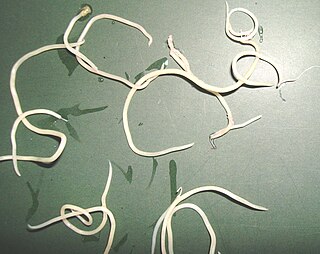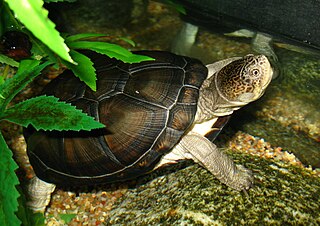
Pelomedusidae is a family of freshwater turtles endemic to sub-Saharan Africa, including Madagascar, São Tomé, and the Seychelles. They range in size from 12 to 45 cm in carapace length, and are generally roundish in shape. They are unable to fully withdraw their heads into their shells, instead drawing them to the side and folding them beneath the upper edge of their shells, hence are called African side-necked turtles.

The phylum Bacteroidota is composed of three large classes of Gram-negative, nonsporeforming, anaerobic or aerobic, and rod-shaped bacteria that are widely distributed in the environment, including in soil, sediments, and sea water, as well as in the guts and on the skin of animals.

Ascaridia galli is a parasitic roundworm belonging to the phylum Nematoda. Nematodes of the genus Ascaridia are essentially intestinal parasites of birds. A. galli is the most prevalent and pathogenic species, especially in domestic fowl, Gallus domesticus. It causes ascaridiasis, a disease of poultry due to heavy worm infection, particularly in chickens and turkeys. It inhabits the small intestine, and can be occasionally seen in commercial eggs.

Chelodina, collectively known as snake-necked turtles, is a large and diverse genus of long-necked chelid turtles with a complicated nomenclatural history. Although in the past, Macrochelodina and Macrodiremys have been considered separate genera and prior to that all the same, they are now considered subgenera of the Chelodina, further Macrochelodina and Macrodiremys are now known to apply to the same species, hence Chelydera is used for the northern snake-necked turtles.

Pelusios is a genus of African side-necked turtles. With 17 described species, it is one of the most diverse genera of the turtle order (Testudines).
Pelusios broadleyi, commonly known as the Turkana mud turtle, Broadley's mud turtle, or the Lake Turkana hinged terrapin, is a species of turtle in the family Pelomedusidae. The species is native to eastern Africa.
The variable mud turtle, also known as Rhodesian mud turtle, Mashona hinged terrapin or variable hinged terrapin, is a species of turtle in the family Pelomedusidae. It is widely distributed in Central, East, and Southern Africa. The species was officially described by John Hewitt in 1927 and had to be broken into subspecies due to color variations on the heads of the turtles acrost the regions.

The East African black mud turtle, also known as the Pan terrapin, is a species of turtle in the family Pelomedusidae, native to eastern and southeastern Africa.

The pinworm, also known as threadworm or seatworm, is a parasitic worm. It is a nematode (roundworm) and a common intestinal parasite or helminth, especially in humans. The medical condition associated with pinworm infestation is known as pinworm infection (enterobiasis) or less precisely as oxyuriasis in reference to the family Oxyuridae.

The nematodes, roundworms or eelworms constitute the phylum Nematoda. They are a diverse animal phylum inhabiting a broad range of environments. Most species are free-living, feeding on microorganisms, but there are many that are parasitic. The parasitic worms (helminths) are the cause of soil-transmitted helminthiases.
Angiostoma carettae is the first species of nematodes known to inhabit turtles. Its specific name comes from its presence in loggerhead sea turtles.

The West African mud turtle, also known as the West African side-necked turtle or swamp terrapin, is a species of turtle in the family Pelomedusidae. Pelusios castaneus is a freshwater species and is endemic to West and Central Africa.
The Ivory Coast mud turtle is a species of turtle in the family Pelomedusidae. It is one of the most recently described turtle species.
The Pelusios cupulatta is typically found in riverine and wetland habitats mainly located in the southern Ivory Coast of West Africa. Endemic to the Upper Guinean forest region such as wetlands/rivers they are usually found primarily in forested banks as well as aquatic vegetation. Compared to other counterparts within its family, P. Cupulatta prefers an abundance of aquatic vegetation as its primary habitat. Despite this, Pelusios castaneus is a potential competitor due to similar habitats albeit different preferences regarding specific locations. Interspecific competition is able to regulate the coexistence of potential competitors but also niche expansion is available within the family when alone.
Comparative to other species at a local spatial level, Pelusios niger and Pelusios cupulatta both belong to larger size categories compared to others within the Pelusios records with the maximum male SCL being 31.3 and the maximum female SCL being 27.1. The two different turtle species are also allopatric, meaning that they are related but occur in separate non-overlapping geographical areas compared to the sympatric of P. castaneus. White P. castaneus intensely uses forested banks, P, and cupulatta aren't typically found in such areas as they aim for places with large amounts of aquatic vegetation. In presence of P. niger, P. cupulatta are usually found less than 10 km away showing how closely these two groups typically reside at roughly close locations.

Williams' mud turtle is a species of turtle in the family Pelomedusidae. The species is endemic to Africa.
Lenakel, or West Tanna, is a dialect chain spoken on the western coast of Tanna Island in Vanuatu.
Halicephalobus gingivalis is a free-living saprophagous nematode species identified and named in 1954 by Stefanski. It is a facultative parasite of horses, invading the nasal cavity, and sometimes numerous other areas, where it produces granulomatous masses. On rare occasion, it can infect humans as well, in whom it is invariably fatal. Based on studies performed on infected horses in Florida, the parasite is associated with swampland environments. These worms are dioecious, with female and male organs having been found in separate individuals. Eggs and immature larvae have been found in tissue samples, indicating an asexual reproductive cycle, and free-living males have been found in soil environments, indicating that sexual reproduction also occurs. The site of entry for the parasite is thought to be through breaks in the skin or through mucous membranes. This nematode is now distributed worldwide, as cases of equine infections have been found in Canada, Florida, the Nordic regions, and Arabian horses alike.
Ostertagia ostertagi, commonly known as the medium stomach worm or brown stomach worm, is a parasitic nematode of cattle. O. ostertagi can also be found to a lesser extent in sheep, goats, wild ruminants, and horses. It causes ostertagiosis, which is potentially fatal in cattle. It is found worldwide and is economically important to cattle industries, particularly those found in temperate climates.

The New Caledonian sea krait is a species of venomous snake in the subfamily Laticaudinae of the family Elapidae. The species is native to the waters around New Caledonia.

Ascarophisnema is a genus of parasitic nematodes, belonging to the family Cystidicolidae. Species of Ascarophisnema are parasitic as adults in the gastrointestinal tract of fish. According to the World Register of Marine Species, the genus currently (2019) includes a single species, Ascarophisnema tridentatum.
Falcaustra is a genus of nematodes belonging to the family Kathlaniidae.











